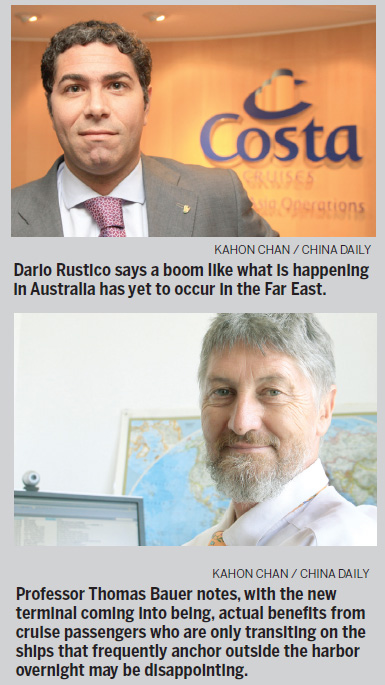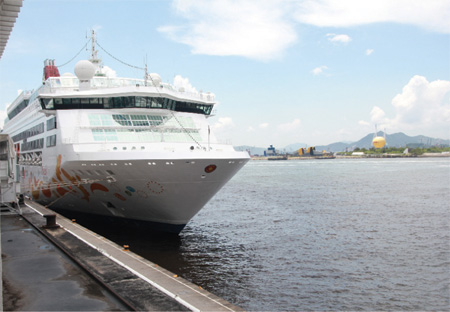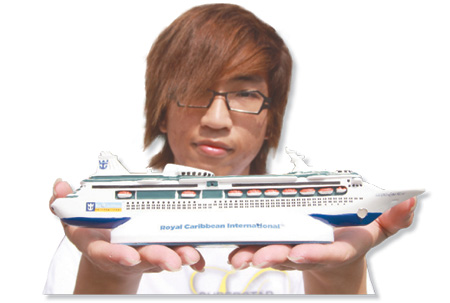More than just a leisurely cruise
Updated: 2011-08-26 06:20
By Kahon Chan(HK Edition)
|
|||||||||
|
Cruise ship spotters only have a couple of months to get busy because for most of the year, the Star Pisces is the only ship to be seen at the Ocean Terminal. Kahon Chan / China Daily |
|
Asuka Lam is devoted to everything about cruising, but not much about the new cruise terminal. Kahon Chan / China Daily |
Work is moving forward on the city's new showpiece - cruise ship terminal - but despite all efforts to transform sailing into a part of the Hong Kong experience, the sea is rougher than most of us have expected. Kahon Chan reports.
Connie Fong, 25, was looking for a honeymoon destination. She was thrilled immediately at the idea of a cruise through the Greek islands when an agent laid out the plan for her. The journey was perfect throughout. By early August, Connie had returned home to Hong Kong from her journey of a lifetime. It was so good that a friend of hers was inspired to sign up for a cruise of her own in September.
Apart from the food lavishly served up on an all-you-can-eat basis, there was the free entertainment. Connie had great fun and also identified the core advantage of going on a cruise - balance between more freedom and less planning.
"Packaged tours are out of my control. Doing my own trip planning seems too troublesome and time-consuming. Cruising is somewhere in the middle with less planning but a lot of individual autonomy."
Connie wondered at the fact that the cruising option seemed to have eluded her previously. Cruise ships have been visiting Hong Kong's famed Victoria Harbour for decades. The Ocean Terminal at Tsim Sha Tsui has been operating since 1966. It has its own shopping mall and easy access to the city.
The Star Pisces of the Star Cruise Line began sailing in and out of Hong Kong, in 1994, plying the waters of the South China Sea following a pattern that insiders call "homeporting". Ships have been rotating over the 17 years since but the Pisces has returned to become the only cruise ship that homeports in Hong Kong year round.
"It was completely different," Connie said, recalling a tour she took with Star Cruise a couple of years ago. "Mine was a one-night sail and there was not much to do except go to the casino. The dining was not of the same class as the fine dining on the European cruise." So with her first cruise experience written off as lackluster, Connie gave little thought to venturing farther, to Vietnam or Hainan Island. "I was not confident about the ship," she said.
Asuka Lam, a 24-year-old student who has set sail from Hong Kong over a hundred times, was fed up with the short, one-night cruises characterized with gamblers' madness and cutback on entertainment.
"You could see scores of housewives queuing up outside the casino right after the buffet dinner, even while the ship was still in Hong Kong waters."
Though these one-night cruises have virtually nowhere to go, the frenetic journeys out onto the high seas make up roughly 90 percent of the cruise passenger traffic coming out of Hong Kong since 2007. About 440,000 people sailed out of Hong Kong in the first half of 2011 on this type of itinerary.
The new cruise terminal under construction at the site of the decommissioned Kai Tak airport could change things, says George Lee, general manager of U-Cruising (Asia Pacific), a booking agency.
"Now when someone tells others about spending HK$20,000 for a cruise like those docking at Tsim Sha Tsui, there is no fantasy." He explained. "But what happened with the terminal at Vancouver was that people would spot much bigger ships and realize, they're nice."
The new Hong Kong terminal that will cost taxpayers HK$7.2 billion would do a better job as a display window for the cruise industry. When the first berth opens in 2013, it will bring economic benefits ranging between HK$860 million and HK$1.09 billion before the end of the year. When the second berth comes into operation in 2015, the two will contribute up to HK$2.56 billion by 2023.
The lucrative estimate, with the multiplier effect taken into account, has made a believer of Professor Thomas Bauer of the School of Hotel and Tourism Management at the Polytechnic University. He noted, however, the actual benefits from cruise passengers who are only transiting on the Queen Mary II and other larger ships that frequently anchor outside the harbor overnight could be disappointing.
"The ship arrives, people book a tour for about HK$500, have a look around and then go back to the ship to eat. It's 3,000 people who are not eating or staying overnight in Hong Kong."

Homeporting may bring in much desired revenues, but Bauer pointed out that cruising in Hong Kong is no "multi-billion industry" and that there are other obstacles. "I am not 100 percent convinced that just because we are going to have a new terminal, any of the big cruise companies will want to homeport a vessel here. We can try by giving them some incentives, but again they have to fill their vessels and the Hong Kong cruise market itself is still very small."
Hong Kong is scheduled to be visited by 87 cruise liners this year. That's down significantly from the 120 ones docked here in 2010. The market inevitably had to shrink. During the first half of 2011, the Hong Kong Tourism Board reported that 79,543 cruise ship passengers arrived in port or sailed out of Hong Kong, accounting for a one-year slippage of 20.8 percent - in marked contrast to the 59.5 percent rebound seen a year earlier.
While Bauer held that versatility should not be considered indicative of the future positioning of cruise ships, it may reveal that cruise lines see better prospects in other ports.
In June, the Royal Caribbean cruise line shocked the industry when it announced it would homeport the 144,000-ton Voyager of the Seas at Shanghai from June to October 2012. The Voyager will dwarf its competitor in Shanghai over the same period, the 70,000-ton Costa Victoria. Still, the Costa represented a 40 percent boost in capacity.
As critics may react in fear of "Hong Kong losing out to Shanghai", a cruise operator has a different concern: the temptation to book passage aboard a better equipped vessel might not work if customers are looking at something else.
"Today a lot of agencies tend to sell on price, which is easy. If you don't correct that and bring more capacity, the price will automatically go down even more," observed Dario Rustico, vice-president of sales and markets of Costa's Pacific Asia Operations. While infrastructure is essential, the company believes consumer demand must come before the berth.
"We do believe in the potential for Hong Kong, (but) we also listen to customers and what they tell us. Basically that is how itineraries are designed."
While ports of call around Hong Kong are not as appealing as those easily accessible from Singapore, Hong Kong's proximity to the vast purchasing power of the mainland is an exclusive gift. Both Singapore and Hong Kong also enjoy year-round conditions suitable for cruising. Shanghai does not.
The tiny market simply cannot meet every one's appetite, and that stands in the way of any boom that the local industry might anticipate. "When you enlarge the market size then automatically more ships come, then you need to differentiate the itineraries and more ports can be put on the map," Rustico said.
At a stage dubbed as "ground zero", Rustico suggested that the governments must identify their target cruise customers and then coordinate specific marketing efforts, with the Vanilla Islands concept initiated by Seychelles, Madagascar, La Runion and Mauritius being an example, rather than self-centred marketing campaigns since "people are coming to leave".
Professor Bauer also buys in to the idea of regional cooperation, as he reminded policy makers that short holidays at work, restrictive access across borders, and an overall lack of interest among travelers in ocean cruising for their first trips abroad may offset some of the effort to tap the affluent mainland market.
The Tourism Commission and Hong Kong Tourism Board told China Daily in a statement that the cooperation with neighboring ports is being stepped up, which includes a web page called "Cruise South China".
They also believe that new port facilities in the region will improve the appeal of cruising in Asia.
The Tourism Board said it will continue its own marketing effort that include "tactical promotions" in the United States, the United Kingdom, Australia and India, as well as consumer education programs aimed at retirees and families in southern China.
The statement reiterates faith on Hong Kong's great potential on cruise tourism and pledges to work closely with industry stakeholders and neighboring ports to attract more ship deployments.
The government promised to give ample time to the terminal operator to look for business before the first berth opens in mid-2013, but the clock is ticking as cruise operators have already assigned much of the vessels for early 2013. The schedule for the Ocean Terminal, January to March in 2012 and 2013 will see a new ship to dock every two days, but the summer months will pretty much be owned by the only devoted operator out of Hong Kong, the Star Cruises.
Once witnessing a high-end vessel moving from a "mountain-view" berth to the other side of the Ocean Terminal just for a panoramic harbor view, cruise ship enthusiast Asuka could muster little excitement for the new berth, given sluggish growth in recent years.
"If the employment only occurs when a ship arrives, the benefit is not significant. What if Star Cruise does not want to dock at the new port?"
Asuka agrees an alternate berth is a late arrival, but he does not feel right about the way it is being publicized.
"The press has been spinning out how shameful it is that ships coming to Hong Kong have to anchor at sea. It feels like we are spending billions of taxpayers' money for less than a dozen large vessels visiting every year."
"The government always bills, how the berth could handle the world's largest ships and how spectacular the place looks. How likely is it for a 220,000-ton vessel to dock here?" All of Asuka's doubts are being poured into his thesis toward his undergraduate degree in tourism. Still, when asked what he would do about the future of cruising in Hong Kong, not even the veteran cruise traveler could offer a clear vision.
(HK Edition 08/26/2011 page4)

